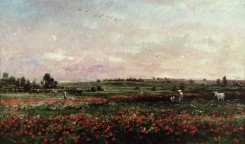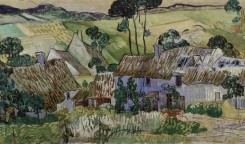by Paula Smith
DAUBIGNY, MONET and VAN GOGH AT THE SCOTTISH NATIONAL GALLERY
This awe-inspiring exhibition contains more than one hundred paintings to admire and marvel at. The three main artists exhibited are Daubigny, Monet and Van Gogh. There are also paintings by Pissaro and Sisley. The individual paintings command respect and acknowledgement of the sheer artistic talent shown. However the lay out of the exhibition has the paintings placed in such a way so that one can recognize the similarities, influences and differences of each artist’s individual technique.

For the amateur of painting there is a realization that the three artists have much in common. There is a display of the three artists’ versions of fields of poppies. This display not only offers the visitor an opportunity to compare and contrast the paintings but also gives an insight into the artists’ vision. After studying up close such a beautiful and enriching scene the remaining paintings speak volumes by conveying each perspective.
Another powerful comparison of works includes ‘moonlight’ paintings where there is a strong projection of feeling, mood, light and absence of light. Although many are likely to have heard of Monet and Van Gogh, Daubigny seems to be less mentioned. The role he played in the lives of Monet and Van Gogh is very significant indeed. He is considered a grand master who has had a very positive impact on both of these artists and this is apparent during the exhibition. However it is not the case that Monet and Van Gogh are merely watered down versions of Daubigny – both these artists obviously have their own well established style of paintings with many people being familiar with their great works such as the ‘Water Lilies’ and ‘The room’.

We get a privileged look at some of Van Gogh paintings before he took his own life and we can also read the quotation where he states his absolute loneliness. We learn he suffered from a troubled mind while living with Daubigny. This exhibition allows us to step inside the artist’s lives and realize how the artist takes the best from outward influences while developing their individual style. Aspects of their lives are revealed to us such as fleeing wars, living on house boats and moving to where they can paint and be true to their own subject matter.
‘Inspiring Impressionism’ is a wonderful exhibition which merits appreciative visitors. From the expert in art to the beginner it offers the artist’s perception of the world which can only bring admiration from the onlooker. In addition there is a very good guide to the exhibition for less than eight pounds. It is a condensed version of the larger book but will allow the reader some in-depth understanding of the artists without any heavy-duty reading. This exhibition is a real artistic treasure and should be thoroughly absorbed and enjoyed.











Another great review Paula, very interesting.